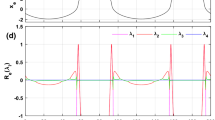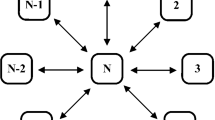Abstract
Considering the influence of electric field and introducing the adaptation current as spike-burst firing mutation parameter, a novel variant Hindmarsh–Rose neural model is proposed to study the firing modes of neural systems. (1) In the case of single HR neural system, it is shown that the firing modal fusion absorption of neuron can be occurred with the increasing of current intensity. A higher sinusoidal current frequency transforms HR neuronal model from asymmetric dual-mode state to symmetric dual-mode state. There exists a singularity at which the neuron has a larger firing mode mutation when the adaptation current mutation parameter is applied. (2) In the case of three-dimensional network with the chemically coupled HR neurons, it is observed that the firing behavior of the core neuron of network has the strongest stability when the noise-like or the periodic electric field is imposed on the vertex neurons and edge center neurons of three-dimensional network. At the singular point of the mutation parameter, the synchronization of the neuron firing modes shows a relationship of nonlinear function when the electric field is not considered with the increasing of the chemical synapse intensity, the synchronization is firstly decreased and then increased. (3) In the case of star network with chemically coupled neurons, the phenomenon of bursting firing modal fusion and absorption can be observed when chemical synapse intensity is larger.



















Similar content being viewed by others
References
A L Hodgkin and A F Huxley J. Physiol. 116 497 (1952)
R Barrio, S Coombes, M Desroches et al Commun. Nonlinear Sci. Numer. Simul. 86 105275 (2020)
R Fitzhugh Biophys. J. 1 445 (1961)
J S Nagumo, S Arimoto and S Yoshizawa Proc. Ire. 50 2061 (1962)
J L Hindmarsh and R M Rose Nature 296 162 (1982)
J L Hindmarsh R. Soc. Lond. B. 221 87 (1984)
Y Wang, Z Wang and W Wang J. Phys. Soc. Jpn. 69 276 (2000)
J M González-Miranda Chaos 13 845 (2003)
M Dhamala, V K Jirsa and M Ding Phys. Rev. Let. 92 074104 (2004)
I Belykh, E D Lange and M Hasle Phys. Rev. Let. 94 188101 (2005)
R J Erichsen, M S Mainieri and L G Brunnet Phys. Rev. E 74 061906 (2006)
R Erichsen and L G Brunnet Phys. Rev. E. 78 061917 (2008)
E D Lange and M Hasle Biol. Cybern. 99 349 (2008)
N Burić, K Todorović and N Vasovi Phys. Rev. E 78 036211 (2008)
M Storace, D Linaro and D Lange Chaos 18 162 (2008)
I Grosu, R Banerjee, P K Roy et al Phys. Rev. E. 80 016212 (2009)
M M Shrii, D V Senthilkumar and J Kurths Phys. Rev. E. 85 057203 (2012)
F M M E M KakmeniMoukamInack et al Phys. Rev. E. 89 052919 (2014)
J Hizanidis, V Kanas, A Bezerianos et al Int. J. Bifurcat. Chaos 24 1450030 (2014)
M Hayati, M Nouri, D Abbott et al IEEE Trans. Circuits II 63 463 (2016)
A Mishra, S Saha, M Vigneshwaran et al Phys. Rev. E. 97 062311 (2017)
R Hosaka and Y Sakai Phys. Rev. E. 92 042705 (2015)
Y Xu, Y Jia, J Ma et al Sci. Rep. 8 1349 (2018)
M Y Ge, Y Jia, Y Xu et al Appl. Math. Comput. 352 136 (2019)
B Dmitri, G Strukov, S Gregory et al Nature 453 80 (2008)
M Y Ge, L L Lu, Y Xu et al Chaos Soliton Fract. 133 109645 (2020)
Y Liu, J Ma, Y Xu et al Int. J. Bifurc. Chaos 29 1950156 (2019)
L L Lu, Y Jia, Y Xu et al Sci. China Technol. Sci. 62 427 (2019)
M Y Ge, Y Jia, L L Lu et al Nonlinear Dyn. 99 2355 (2020)
Y Xu, L L Lu, M Y Ge et al Eur. Phys. J. B. 92 245 (2019)
Y Xu, Y Jia, H T Wang et al Nonlinear Dyn. 95 3237 (2019)
R Garrappa Nonlinear Sci. Numer. Simul. 90 105359 (2020)
L L Lu, C Bao, M Y Ge et al Eur. Phys. J. Spec. Top. 228 2101 (2019)
L L Lu, Y Jia, J B Kirunda et al Nonlinear Dyn. 95 1673 (2019)
K Usha and P A Subha Nonlinear Dyn. 96 2115 (2019)
K Usha and P A Subha Biosystems 178 1 (2019)
I Bashkirtseva, L Ryashko and E Slepukhina Phys. Rev. E. 99 062408 (2019)
K Rajagopal, A J M Khalaf, F Parastesh et al Nonlinear Dyn. 98 477 (2019)
S Kundu, B K Bera, D Ghosh et al Phys. Rev. E. 99 022204 (2019)
S Armand et al Commun. Nonlinear. Sci. Numer. Simul. 84 105208 (2020)
S Wang, S He, K Rajagopal et al Eur. Phys. J. Spec. Top. 229 929 (2020)
Y Yu, M Shi, H Kang et al Nonlinear Dyn. 100 891 (2020)
X B Rao, X P Zhao, J S Gao et al Commun. Nonlinear. Sci. Numer. Simulat. 94 105569 (2021)
A Shilnikov and M Kolomiets Int. J. Bifurcat. Chaos 18 2141 (2008)
D Li, Y Zheng and Y Yang Indian J. Phys. 93 1477 (2019)
Z L Hou, J Ma, X Zhan et al Chaos Soliton Fract. 142 110522 (2021)
M Lv and J Ma Neurocomputing 205 375 (2016)
M Lv, C N Wang, G D Ren et al Nonlinear Dyn. 85 1479 (2016)
A Wolf, J B Swift, H L Swinney et al Physica D 16 285 (1985)
J X Chen, H Zhang, L Y Qiao et al Commun. Nonlinear Sci. Numer. Simul. 54 202 (2018)
A Shilnikov, L Shilnikov et al Math. J. 5 269 (2005)
J Ma, W Xu, P Zhou et al Phys. A 536 122598 (2019)
L L Lu, Y Jia, M Y Ge et al Nonlinear Dyn. 100 877 (2020)
A S Pikovsky and K Jurgen Phys. Rev. Let. 78 775 (1997)
Y Xu, Y Jia, J B Kirunda et al Complexity 2018 3012743 (2018)
Y Xu, Y Jia, J Ma et al Chaos Soliton Fract. 104 435 (2017)
K Usha J. Mod. Phys. C 29 1850023 (2018)
G W Wang, D Yu, Q M Ding et al Chaos Soliton Fract. 150 111210 (2021)
K K Wang, H Ye, Y J Wang et al Indian J. Phys. 96 1943 (2022)
G W Wang, L J Yang, X Zhan et al Nonlinear Dyn. 107 3945 (2022)
M Nag Indian J. Phys. 94 689 (2020)
G W Wang, Y Wu, F L Xiao et al Physica A 597 127274 (2022)
Y Guo, L Wang, F Wei et al Indian J. Phys. 94 1625 (2020)
G W Wang, M Y Ge, L L Lu et al Nonlinear Dyn. 103 2627 (2021)
J C Shi, M Luo et al Indian J. Phys. 92 1009 (2018)
G W Wang, Y Xu, M Y Ge et al AEU Int. J. Electro. Commun. 120 153209 (2020)
G W Wang and Y Fu Math. Biosci. Eng. 20 3944 (2023)
D Yu, G W Wang, T Y Li et al Commun. Nonlinear Sci. Numer. Simul. 117 106894 (2023)
D Yu, X Y Zhou, G W Wang et al Cognit. Neurodyn. 16 887 (2022)
T Y Li et al Nonlinear Dyn. 108 2611 (2022)
Acknowledgments
This work is supported by Science and Technology Project of Jiangxi Provincial Department of Education under Grants Nos. GJJ2202903 & GJJ203111, Science and Technology Project of Yuzhang Normal University under Grants No. YZYB-21-17. Talent Introduction Project (No. NGRCZX-22-07), Special Fund for Doctor of Science and Technology Program of Nanchang Institute of Technology under Grants No. NGKJ-21-03.
Author information
Authors and Affiliations
Corresponding author
Ethics declarations
Competing interest
The authors declare that they have no potential conflict of interest.
Additional information
Publisher's Note
Springer Nature remains neutral with regard to jurisdictional claims in published maps and institutional affiliations.
Rights and permissions
Springer Nature or its licensor (e.g. a society or other partner) holds exclusive rights to this article under a publishing agreement with the author(s) or other rightsholder(s); author self-archiving of the accepted manuscript version of this article is solely governed by the terms of such publishing agreement and applicable law.
About this article
Cite this article
Wang, GW., Fu, Y. Modes transition and network synchronization in extended Hindmarsh–Rose model driven by mutation of adaptation current under effects of electric field. Indian J Phys 97, 2327–2337 (2023). https://doi.org/10.1007/s12648-023-02613-2
Received:
Accepted:
Published:
Issue Date:
DOI: https://doi.org/10.1007/s12648-023-02613-2




